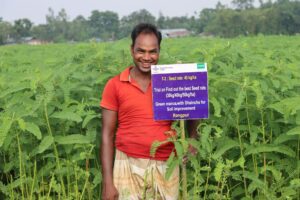

The potential of Indian agriculture was central in the talks during India Foodex 2011 and GrainTech India 2011. Themed “Farm-to- Fork,” a three-day international conference (9-11 September) was held on the Palace Grounds of Bangalore. It was organized by Media Today Pvt. Ltd.
Counselor of Agriculture of the Netherlands Hank van Duijn inaugurated the event, which was attended by 150 delegates from 18 countries.
Indian agriculture is acknowledged as the emerging food basket in the world. Indian scientists and farmers have achieved great feats in crop production. The Green Revolution and White Revolution are examples that prove that India has the resources, talent, and labor not only to feed its population but also to export food to other countries.
Despite all the progress that India has made on the farm front, many aspects have remained neglected. Low productivity of crops, insufficient storage space, improper distribution channels, inadequate supply chain management, and poor implementation of policies have acted as major constraints. To wake up this “sleeping giant,” what is needed is cooperation and synergy among key players such as policymakers, researchers, entrepreneurs, motivators, marketers, and consumers.

At the show
The event also showcased agricultural products from various companies. Examples are steel stock silos and food grain handling systems of Alapala Machine Industries from Turkey; flour-semolina and corn mills, feed mills, and transportation and storage solutions of Uger Makina also from Turkey; automated greenhouse solutions, including heating, cooling, and fertigation systems of Van der Hoeven from the Netherlands; oilseed, pulses, spices, and natural gum of Warka Trading House from Ethiopia; Shami Goat Yiannakis N Antoniades from Cyprus; seaweed organic fertilizers, fodder, and powder of Quingdao Bright Moon Seaweed Group from China; plus other cost-effective solutions to enhance farmers’ profitability from Taiwan and Thailand, among other countries. Indian corporate stalwarts were also present such as Jain Irrigation, Reliance, Mahindra, and Greaves.
All about milk
Part of the overall event was DairyTech India 2011, which gathered stakeholders from dairy products, livestock, India is emerging as the frontliner in agriculture and could become the global food basket by S. Jafar Naqvi technology, and allied sectors. They presented and discussed genetic and productivity improvement of dairy animals, better cow’s health, dairy technologies, and consumer-driven products, among other topics. India ranks first in the world in milk production, with an annual output of more than 112 million tons. The value of the dairy in the market is 26 trillion rupees (US$60 billion) and the industry is predicted to grow at 4–5% per year. It is expected to reach $83 billion by 2015. As a major contributor to the food processing industry in India, dairy has the biggest share of the country’s agricultural gross domestic product. However, the dairy industry has not caught the fancy of the younger generation despite opportunities. Most farmers keep animals only for extra income. Others wish to diversify and explore opportunities in this sector. Southern India has been the major hub for agri- and food-processing activities. That is why farmers are encouraged in the southern states to diversify into dairy and poultry. During the event, many visitors showed interest in venturing into dairy farming. After living a stressful urban and career-oriented life, many wish to go back to their village homes and use their ancestral land for dairying or farming activities.
_________________________________________
Mr. S. Jafar Naqvi is the chief coordinator of GrainTech India 2011.









